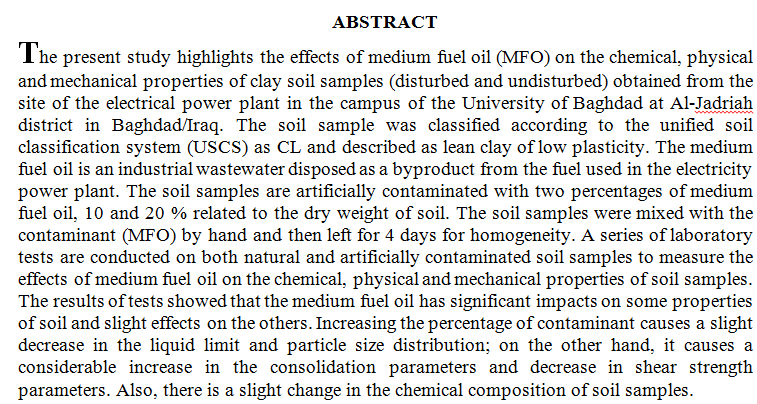
This study was conducted on the effect of the sedimentary source (the sediments coming from both the Iraqi-Iranian borderline and the Tigris river) on the optical and textural features, especially sphericity and roundness of feldspar minerals (potassium and plagioclase types) in soils of the southern part of the alluvial plain. Eight pedons were selected to represent the study area, five of them represented sediments coming from the borderline, which included pedons of (Badra, Taj Al-Din, Al-Shihabi, Jassan, and Galati), while two of them represent the sediments of the Tigris River (Essaouira, Al-Dabouni), the pedon of Ali Al-Gharbi was represented the mixing area of sediments of all the floods coming from the borderline and the sediments o
... Show More (2)
(2)
Polyaniline polymer has been prepared by chemical oxidation
polymerization method in laboratory successfully. The PANI and
(PVA+PVP) as a polymer blends in different percentage (30%, 50%,
70%) from Polyaniline was prepared. The sample was studies as
optical properties by UV-vis spectrophotometer at (400-700) nm.
The result of optical energy gap was 2.23 eV for pure (PVA+ PVP)
and with additive was increasing with increasing PANI concentration
to become (2.49 for 30% to 2.52 for 70%) PANI. The goal of this
project is prepare triple blend polymer and study the effect when add
conductive polymer (Polyaniline) on the optical properties and
calculate optical constant as energy gap, refractive index, dielectric
The structural, optical properties of copper oxide thin films ( CuO) thin films which have been prepared by thermal oxidation with exist air once and oxygen another have been studied. Structural analysis results of Cu thin films demonstrate that the single phase of Cu with high a crystalline structure with a preferred orientation (111). X-ray diffraction results confirm the formation of pure (CuO) phase in both methods of preparation. The optical constant are investigated and calculated such as absorption coefficient, refractive index, extinction coefficient and the dielectric constants for the wavelengths in the range (300-1100) nm.
This study dealt with the management strategy as an independent variable and the integrated industrial distribution as a variable. The study aimed at finding the integrated industrial distribution that fits with the management strategy in providing the needs of the firm on the one hand and reducing the cost of management that is reflected in increasing its profits.
The researcher selected the data from (130) decision makers in the corporation and used the questionnaire as a tool for collecting data and used a set of statistical tools and tools suitable for the nature of information and were processed using the data analysis system (SPSS version 24) Based on the analysis of the responses of the sample and the test of correlation and
Ti6Al4V thin film was prepared on glass substrate by RF
sputtering method. The effect of RF power on the optical properties
of the thin films has been investigated using UV-visible
Spectrophotometer. It's found that the absorbance and the extinction
coefficient (k) for deposited thin films increase with increasing
applied power, while another parameters such as dielectric constant
and refractive index decrease with increasing RF power.
Thin films of Mn2O3 doped with Cu have been fabricated using the simplest and cheapest chemical spray pyrolysis technique onto a glass substrate heated up to 250 oC. Transmittance and absorptance spectra were studied in the wavelength range (300 -1100) nm. The average transmittance at low energy was about 60% and decrease with Cu doping, Optical constants like refractive index, extinction coefficient and dielectric constants (εr), (εi) are calculated and correlated with doping process.
The aim of this study was to investigate the effect of operating variables on, the percentage of removed sludge (PSR) obtained during re-refining of 15W-40 Al-Durra spent lubricant by solvent extraction-flocculation treatment method. Binary solvents were used such as, Heavy Naphtha (H.N.): MEK (N:MEK), H.N. : n-Butanol (N:n-But), and H.N. : Iso-Butanol (N:Iso:But). The studied variables were mixing speed (300-900, rpm), mixing time (15-60, min), and operating temperature (2540, oC). This study showed that the studied operating variables have effects where, increasing the mixing time up to 45 min for H.N.: MEK, H.N.: n-Butanol and 30 min for H.N.: Iso-Butanol increased the PSR, after that percentage was decreased; increasing t
... Show MoreAbstract
This study was conducted by using soil map of LD7 project to interpret the
distribution and shapes of map units by using the index of compaction as an
index of map unit shape explanation. Where there were wide and varied
ranges of compaction index of map units, where the maximum value was
0.892 for MF9 map unit and the lower value was 0.010 for same map unit.
MF9 has wide range appearance of index of compaction after those indices
were statistically analyzed by using cluster analysis to group the similar
ranges together to ease using their values, so the unit MF9 was considered as
key map unit that appears in the soils of LD7 project which may be used to
expect another map units existence in area of

